Phalaenopsis offer a simple introduction to growing orchids, as well as potentially building a healthy collection of native plants. Their vibrant colours make them attractive plants that will thrive in most parts of the house, provided they get reasonable humidity and appropriate winter care.
In warmer parts of Australia, moth orchids grow well outdoors too, and can be used as natural epiphytes on garden trees to add more summer interest. However you plan on growing these vivacious moth orchids, we’ve got an in depth guide below, including propagation tips, and a list of fifteen of the best varieties to grow at home in Australia.
More...
Family: | Orchidaceae |
|---|---|
Genus: | Phalaenopsis |
Species: | Various (seventy known) |
Common Name: | Moth orchids |
Origin: | Southeast Asia, China, India, New Guinea and Australia |
Location: | Indoor or outdoor |
Type: | Perennial epiphytes and lithophytes |
Growth: | 20 cm - 120 cm tall (varies on species and cultivar) |
Sun requirements: | Bright but indirect light |
Foliage Colour: | Green |
Flower Colour: | Various (variations on pinks, purples, whites and yellows) |
Flowering: | All year indoors, summer outdoors |
Fruits: | None |
Maintenance level: | Low to medium |
Poisonous for pets: | Non-toxic to cats and dogs |
What are Phalaenopsis?

Moth orchids, the common name for Phalaenopsis, make up a genus containing around seventy species of flowering orchids. Every plant in the genus is either an epiphyte or a lithophyte, meaning they cling to rocks, crevices or tree bark for stability, while feeding from humidity and rainfall.
As the plants develop, they can create divisions of themselves from their roots, or by rooting from old flowering stems (if you grow orchids at home, this is the easiest way to propagate new ones, as the new rosettes of foliage usually begin to root into the air).
Some moth orchids, like Phalaenopsis philippinensis, have dense flowering stems, with over thirty flowers, all in bloom at once. Others have as few as two or three flowers at any one time, but tend to flower over a long period, and repeat flower more reliably after deadheading.
Natural Habitat of Moth Orchids
Phalaenopsis are native to Australia, New Guinea, China, Taiwan, India and Southeast Asia, but the densest and most varied habitats are found in Indonesia and the Philippines.
In all cases, they have tropical or subtropical levels of humidity. Providing that at home can be difficult, particularly in southern Australia, but it is very much possible, and if you get it right, moth orchids are actually pretty simple plants to grow.
Main Groups and Types of Moth Orchids
There are seventy species of moth orchids, and most are sold as true species varieties, rather than cultivated or hybridised plants. Those seventy species fall into four subgenera;
- Phalaenopsis subgen. Phalaenopsis
- Phalaenopsis subgen. Parishianae
- Phalaenopsis subgen. Hygrochilus
- Phalaenopsis subgen. Ornithochilus
Each group is distinct in flower shape, stem length, colouration and in how it roots, but there is some confusion about how and where to place each subgenera in relation to each other, with multiple former subgenera now grouped in with the main four.
When it comes to identifying moth orchids, it’s generally simpler to stick to the species, as even within groups, colourings can match other subgenera more closely.
Native Moth Orchids
There are over seventy species of moth orchids and many have naturalised in Australia, but only one is truly native. Phalaenopsis rosenstromii is the Australian native moth orchid, and is easily recognisable thanks to its unique petal structure, and vividly crisp white colouring.
The two true petals (the forwardmost petals on either side) are distinctly diamond shaped, with sharply pointed triangular sepals beneath them. The top sepal is indistinct, with a simple curved shape, but the lip (which guides pollinators to the bright yellow throat) is often loosely curled inwards.
P. rosenstromii is found in the wild in north-east Queensland, and should only ever be grown from cultivated stock, not collected from the wild in any form. Over collection does threaten the species in nature, so make sure you find your native moth orchids from reputable sources.
Best Moth Orchid Varieties to Grow in Australia
The native moth orchid, P. rosenstromii, is the best choice for any Australian home, and any tropical-subtropical gardens, but we thought we’d give you some further inspiration for other tropical and subtropical moth orchids that will do well indoors in any part of the country.


Get Your Free Guide:
Master Growing Australian Natives eBook
A Must Have Complete Guide for Every Australian Garden
Get Your Free Guide:
Master Growing Australian Natives eBook
A Must Have Complete Guide for Every Australian Garden
1. Phalaenopsis aphroditeFound in south-eastern Taiwan and the Philippines, P. aphrodite is a gorgeous moth orchid with large petals, and flower spikes that can hold about a dozen flowers at once. They can be easily mistaken for P. rosenstromii (the Australian native moth orchid) but have much larger lower sepals, and a huge lower lip. | 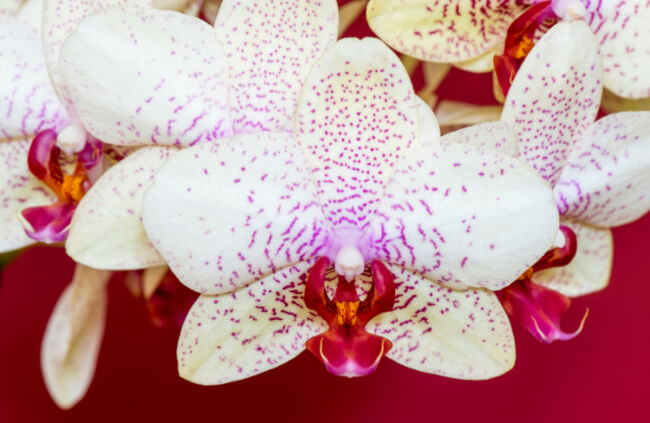 |
2. x DoritaenopsisAlso called Doritis x Phalaenopsis, x Doritaenopsis is a wide ranging genus of artificially created hybrids between Doritis and Phalaenopsis. The genus, though artificial, adapts well to the same conditions as other moth orchids, and comes in a wider range of shapes, sizes and colours, including some spectacularly vibrant speckled pink varieties. | 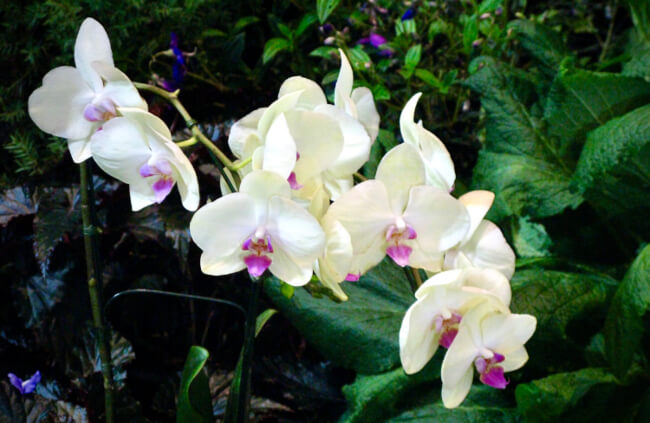 |
3. Phalaenopsis schillerianaThe lilac flowers of P. schilleriana, particularly when grown in hanging containers tend to flower in generous waves, meaning you can often have as many as five flowering stems all active together, for over two months at a time. In good conditions, with medium-high humidity (70-75%) they will produce delicate pinky-white flowers, with spotted throats and double-pointed lips. |  |
4. Phalaenopsis bellinaP. bellina isn’t an orchid for ornament, but it’s a prize for any collector. With white or yellow petals, fading into a bright fuscia-coloured throat, they are utterly unique. Their flowers are held for a few months at a time, but they are much smaller than the leaves, and develop on very short stems. | 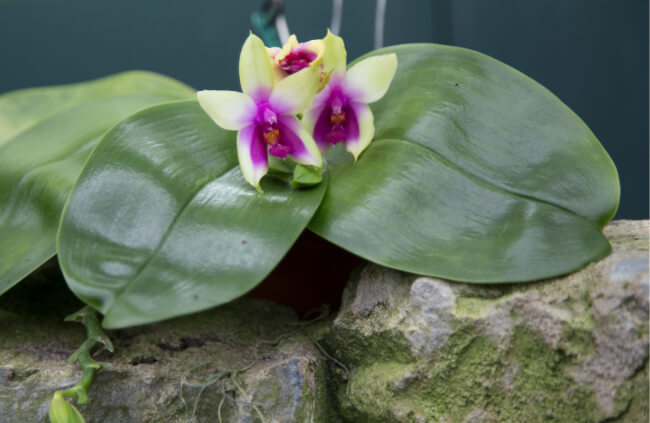 |
5. Phalaenopsis giganteaOne of the largest moth orchids you can grow in cultivation is P. gigantea, but despite its gigantic name and leaves, its flowers aren’t much larger than average. That means you can benefit from manageable but beautiful freckled petals in a near perfect symmetry, for several months, but have the added bonus of structural foliage for the rest of the year. |  |
6. Phalaenopsis violaceaIt’s quite obvious why these tiny moth orchids got their name. P. violacea are so similar in size, and colour, to violas, with flower spikes rarely reaching more than 7 cm tall. They come in a variety of colours, but all are somewhere between white and red – usually fading from purple throats to white petals. | 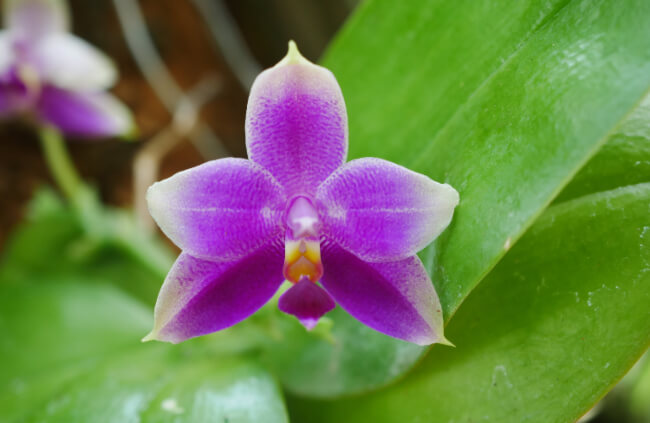 |
7. Phalaenopsis equestrisNative to the Philippines and Taiwan, this is one of the most commonly hybridised moth orchids there is, with compact flowers on dense inflorescences that can hold onto flowers for up to six months if well-watered and fed during the flowering stage. Most cultivated moth orchids you can buy in garden centres or supermarkets, if they don’t have a given name or species details, will have some genes in their make-up from P. equestris. | 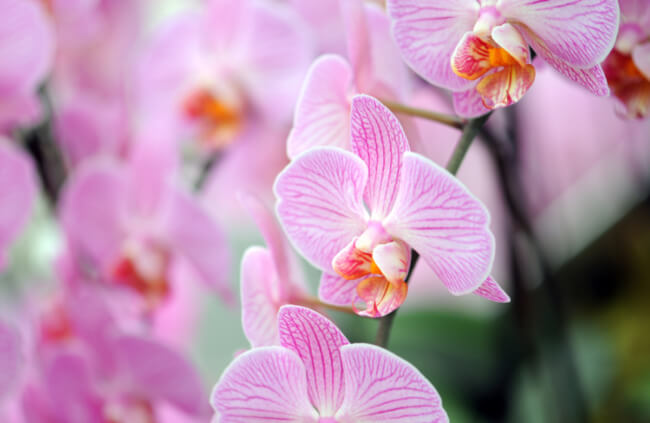 |
8. Phalaenopsis tetraspisFound wild in northern Sumatra, the Andaman Islands and the Nicobar Islands in the Indian Ocean, P. tetraspis is one of the rarest moth orchids in the wild, and one of the most beautiful you can find in cultivation.
If you can find one from reputable sources, or take divisions from a friend, you will never have an orchid with more magical flowers. Each flower, petal, and sepal, has unique red markings. Some are faded patches, others are distinct lines or freckles, but no single petal is ever the same. If you’re going to build yourself an orchid collection, you shouldn’t do it with P. tetraspis. | 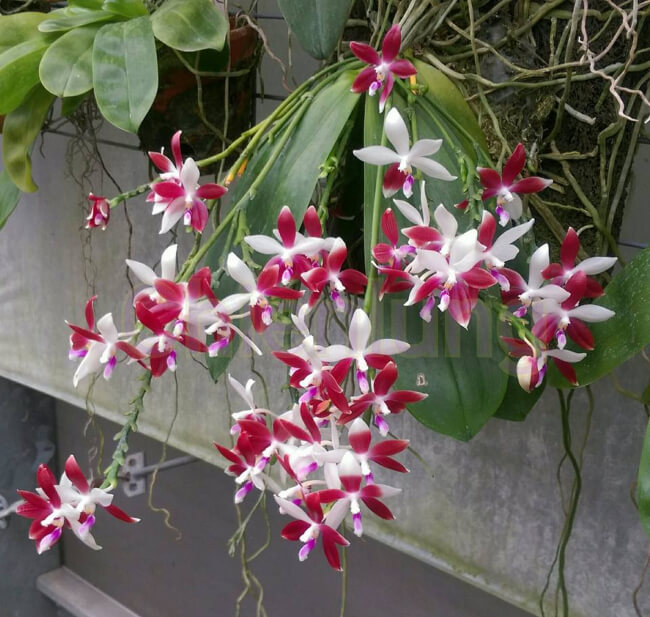 Source: OrchidRoots |
9. Phalaenopsis lobbiiYou’d be forgiven for thinking that P. lobbii was named for its deeply lobed lip, but that’s just a happy coincidence. Like most moth orchids, it was named after its discoverer, the British plant hunter Tomas Lobb. While it is one of the smallest moth orchids you can grow, its leaves and roots are well structured, and grow well from keiki even when left on the plant. The easiest way to identify them is their marmalade coloured lobed lips, sitting beneath a pristinely white set of petals and sepals. | 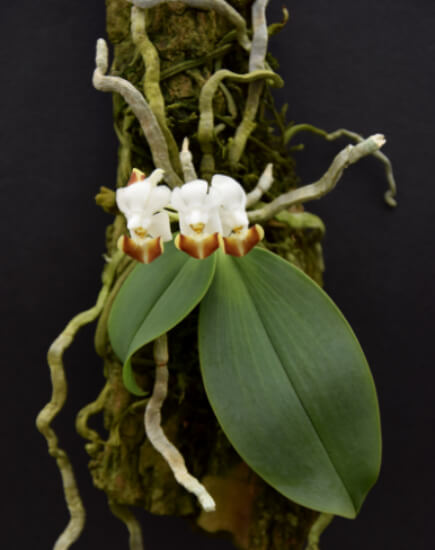 |
10. Phalaenopsis lindeniiAnother Philippine native, P. lindenii, has spectacular colouration and a perfect symmetrical fade from white petal and sepal tips, down to a pink and yellow striped lip. Up close, the combination of lip and throat look like a doll, with its golden arms outstretched. Its flowers are uniform, and tend to happen on one inflorescence at a time, with 10-12 flowers open at once. | 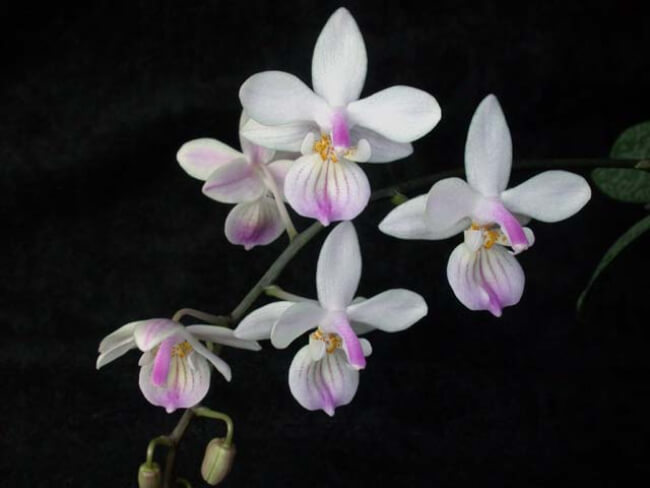 Source: Wikipedia |
11. Phalaenopsis hieroglyphicaI’ve always found the P. hieroglyphica to be quite tricky to grow, but when you do find the right spot, it will reward you with generous flowering and dazzling colour. If over-humidified, its leaves will become quite tatty, and may even get some signs of botrytis, so keep these patterned blooms in a well ventilated space, and never water unless it needs it. | 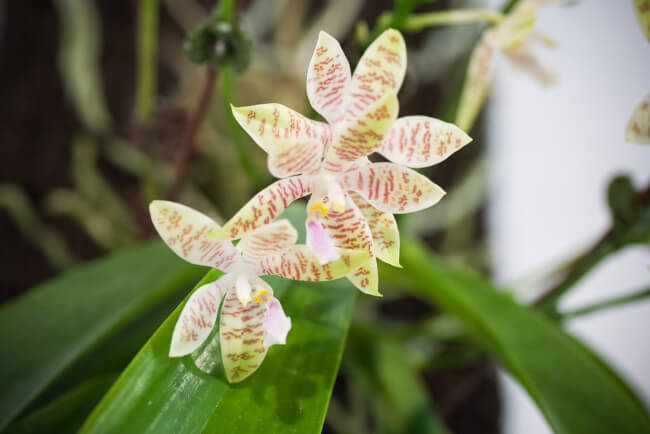 Source: Travaldo's blog |
12. Phalaenopsis bastianiiA great statement moth orchid species is P. bastianii, which can be pruned neatly, or left to grow leggy. In both cases, you’ll get eye-catching flowers, with long, soft, rounded foliage that provides the perfect backdrop from them, wherever you position them. Even in part shade, P. bastianii can hold onto its blotched red and cream flowers for up to three months, making it ideal for quite tricky growing conditions. | 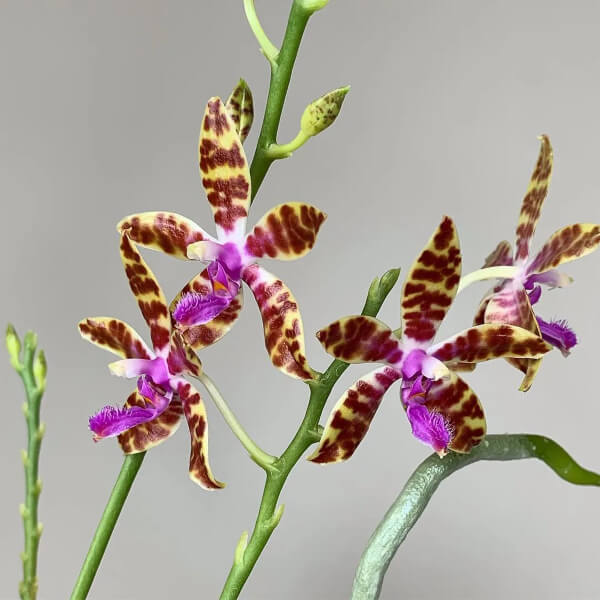 Source: Here But Not |
13. Phalaenopsis fuscataFound only in central Malaysia, P. fuscata is a resilient moth orchids with narrow petals and sepals, and a cute little cupped lip, leading to a ribbed red and white throat (some cultivars are red and yellow, and potting medium can affect colour too). If you want to grow something a little bit different, and like the idea of unusual non-native flowers in your home, P. fuscata is a great place to start. | |
14. Phalaenopsis deliciosaP. deliciosa can be grown in most conditions, whether it's hanging in clear pots, or pinned to a moss board. Their inflorescences are short, but can be packed with four or five tightly spaced flowers, and are usually accompanied by several more stems at once. In warmer parts of Australia, P. deliciosa are a reliable species to try growing if you want to move away from pots, and start experimenting with boards and moss as a growing medium. | 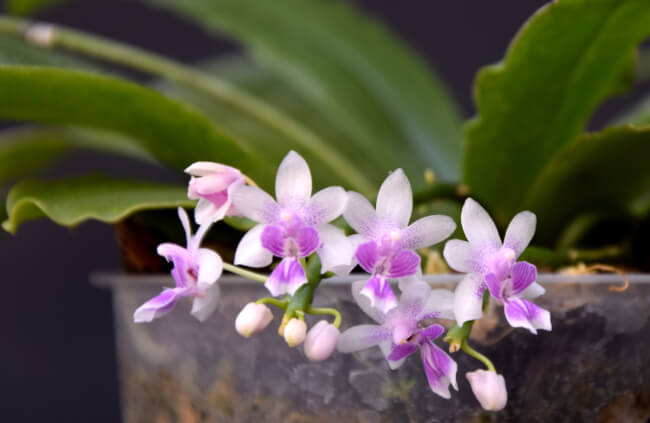 |
15. Phalaenopsis pulcherrimaNative to Hainan, but now very much endangered through over collection and habitat loss, P. pulcherrima is a lithophilic species (meaning it grows naturally by clinging to cracks in rocks, rather than trees like most species). They can be bought and cultivated at home, but make sure you take finding a reputable supplier seriously. | 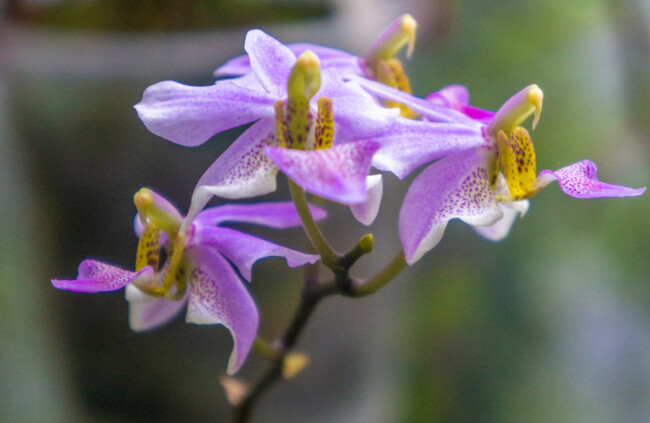 |
1. Phalaenopsis aphrodite

Found in south-eastern Taiwan and the Philippines, P. aphrodite is a gorgeous moth orchid with large petals, and flower spikes that can hold about a dozen flowers at once.
They can be easily mistaken for P. rosenstromii (the Australian native moth orchid) but have much larger lower sepals, and a huge lower lip.
2. x Doritaenopsis

Also called Doritis x Phalaenopsis, x Doritaenopsis is a wide ranging genus of artificially created hybrids between Doritis and Phalaenopsis. The genus, though artificial, adapts well to the same conditions as other moth orchids, and comes in a wider range of shapes, sizes and colours, including some spectacularly vibrant speckled pink varieties.
3. Phalaenopsis schilleriana

The lilac flowers of P. schilleriana, particularly when grown in hanging containers tend to flower in generous waves, meaning you can often have as many as five flowering stems all active together, for over two months at a time.
In good conditions, with medium-high humidity (70-75%) they will produce delicate pinky-white flowers, with spotted throats and double-pointed lips.
4. Phalaenopsis bellina

P. bellina isn’t an orchid for ornament, but it’s a prize for any collector. With white or yellow petals, fading into a bright fuscia-coloured throat, they are utterly unique. Their flowers are held for a few months at a time, but they are much smaller than the leaves, and develop on very short stems.
5. Phalaenopsis gigantea

One of the largest moth orchids you can grow in cultivation is P. gigantea, but despite its gigantic name and leaves, its flowers aren’t much larger than average.
That means you can benefit from manageable but beautiful freckled petals in a near perfect symmetry, for several months, but have the added bonus of structural foliage for the rest of the year.
6. Phalaenopsis violacea

It’s quite obvious why these tiny moth orchids got their name. P. violacea are so similar in size, and colour, to violas, with flower spikes rarely reaching more than 7 cm tall.
They come in a variety of colours, but all are somewhere between white and red – usually fading from purple throats to white petals.
7. Phalaenopsis equestris

Native to the Philippines and Taiwan, this is one of the most commonly hybridised moth orchids there is, with compact flowers on dense inflorescences that can hold onto flowers for up to six months if well-watered and fed during the flowering stage.
Most cultivated moth orchids you can buy in garden centres or supermarkets, if they don’t have a given name or species details, will have some genes in their make-up from P. equestris.
8. Phalaenopsis tetraspis

Source: OrchidRoots
Found wild in northern Sumatra, the Andaman Islands and the Nicobar Islands in the Indian Ocean, P. tetraspis is one of the rarest moth orchids in the wild, and one of the most beautiful you can find in cultivation.
If you can find one from reputable sources, or take divisions from a friend, you will never have an orchid with more magical flowers. Each flower, petal, and sepal, has unique red markings.
Some are faded patches, others are distinct lines or freckles, but no single petal is ever the same. If you’re going to build yourself an orchid collection, you shouldn’t do it with P. tetraspis.
9. Phalaenopsis lobbii

You’d be forgiven for thinking that P. lobbii was named for its deeply lobed lip, but that’s just a happy coincidence. Like most moth orchids, it was named after its discoverer, the British plant hunter Tomas Lobb.
While it is one of the smallest moth orchids you can grow, its leaves and roots are well structured, and grow well from keiki even when left on the plant. The easiest way to identify them is their marmalade coloured lobed lips, sitting beneath a pristinely white set of petals and sepals.
10. Phalaenopsis lindenii

Source: Wikipedia
Another Philippine native, P. lindenii, has spectacular colouration and a perfect symmetrical fade from white petal and sepal tips, down to a pink and yellow striped lip.
Up close, the combination of lip and throat look like a doll, with its golden arms outstretched. Its flowers are uniform, and tend to happen on one inflorescence at a time, with 10-12 flowers open at once.
11. Phalaenopsis hieroglyphica

Source: Travaldo's blog
I’ve always found the P. hieroglyphica to be quite tricky to grow, but when you do find the right spot, it will reward you with generous flowering and dazzling colour.
If over-humidified, its leaves will become quite tatty, and may even get some signs of botrytis, so keep these patterned blooms in a well ventilated space, and never water unless it needs it.
12. Phalaenopsis bastianii

Source: Here But Not
A great statement moth orchid species is P. bastianii, which can be pruned neatly, or left to grow leggy. In both cases, you’ll get eye-catching flowers, with long, soft, rounded foliage that provides the perfect backdrop from them, wherever you position them.
Even in part shade, P. bastianii can hold onto its blotched red and cream flowers for up to three months, making it ideal for quite tricky growing conditions.
13. Phalaenopsis fuscata
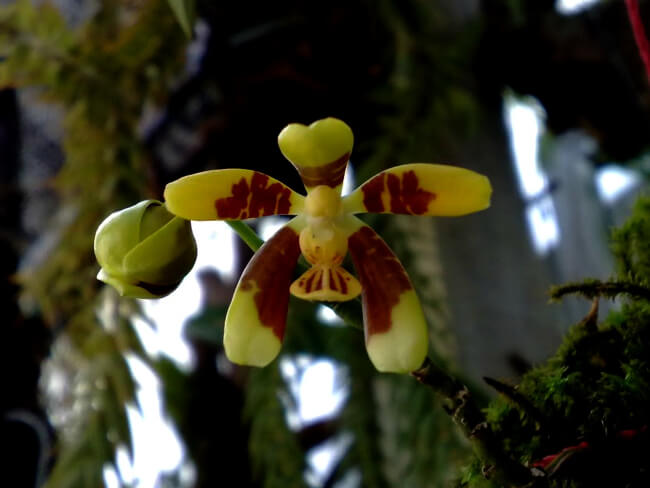
Source: orchidofpeninsularmalaya.blogspot.com
Found only in central Malaysia, P. fuscata is a resilient moth orchids with narrow petals and sepals, and a cute little cupped lip, leading to a ribbed red and white throat (some cultivars are red and yellow, and potting medium can affect colour too).
If you want to grow something a little bit different, and like the idea of unusual non-native flowers in your home, P. fuscata is a great place to start.
14. Phalaenopsis deliciosa

P. deliciosa can be grown in most conditions, whether it's hanging in clear pots, or pinned to a moss board. Their inflorescences are short, but can be packed with four or five tightly spaced flowers, and are usually accompanied by several more stems at once.
In warmer parts of Australia, P. deliciosa are a reliable species to try growing if you want to move away from pots, and start experimenting with boards and moss as a growing medium.
15. Phalaenopsis pulcherrima

Native to Hainan, but now very much endangered through over collection and habitat loss, P. pulcherrima is a lithophilic species (meaning it grows naturally by clinging to cracks in rocks, rather than trees like most species).
They can be bought and cultivated at home, but make sure you take finding a reputable supplier seriously.
How to Grow Phalaenopsis in Australia
Moth orchids need tropical conditions, so growing them outdoors in most parts of southern Australia simply isn’t a possibility, but they can be grown in glasshouses, conservatories, and in hot summers, do seem to benefit from a few weeks outdoors.
Our guide focuses on how to grow moth orchids indoors, but we’ll share some tips on how to adapt your outdoor growing conditions to give moth orchids the best possible chance.
Growing Moth Orchids Indoors
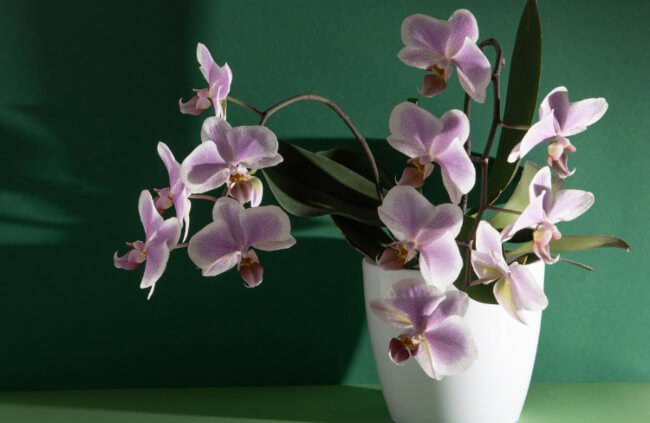
Moth orchids grow best indoors, as it’s simpler to control their light, temperature and humidity, but it’s important to avoid common mistakes, like overheating, or over ventilating them.
Essentially, you just need a good free-draining orchid potting mix (usually made up of bark with some crushed charcoal to prevent bacteria) to grow moth orchids successfully. However, finding the right conditions in your home can be tricky.
As long as you provide your moth orchids with bright light throughout the day, and protect them from direct sun from around midday to 4 pm, in a room with just above average humidity, they will grow and flower well.
Moth Orchid Pots
In nature, moth orchids grow with their roots exposed to the light, hanging from trees, or clutching onto rocks, so clear pots are essential to grow them well. If you can get your hands on perforated pots, that’s better still as this will allow the roots of your moth orchid to breathe, and make sure there are never anaerobic conditions for water to stagnate.
Best Potting Mix for Moth orchid
The best potting mix for moth orchids is bark and charcoal. They don’t need any special treatment or amendments, so you can buy any bark-based orchid mix and use it straight from the bag whether you’re planting a cutting or potting up a mature moth orchid.
Humidity Requirements
Moth orchids can cope with a relative humidity of just 40%, but do best in higher humidity paired with ventilation. Ideally, an open window with humidity between 60-80% should be provided.
In closed rooms, 60-65% is the average relative humidity in most homes, so either a ventilated bathroom, or ventilated room with a humidifier is best. (See our review of the best humidifiers here.)
Light Requirements
Moth orchids need bright light and reasonably high temperatures, but don’t cope well if they are exposed to direct afternoon sun. Either place them directly in an east-facing window, or 1-2 m from a bright North facing window.
Wherever they are planted, you can protect moth orchids from afternoon sun by placing them amongst other house plants for dappled shade (this will also help to hold more humidity in the air around them).
How to Grow Phalaenopsis
Growing moth orchids outdoors is much trickier, as they require temperatures of at least 19-20°C all year round, and can just about cope down to 16°C at night. Through summer, they prefer much warmer temperatures of 25-30°C.
That means that for anyone in southern Australia, and most of Central or Western Australia, they will need to be grown in a greenhouse, under glass, or in a conservatory, where their temperatures are properly regulated.
In those conditions, humidity should be reasonably high anyway, but leaving a few buckets of water around, and occasionally wetting the floor will help to maintain humidity.
Other than that, their growing conditions are the same as if you grow moth orchids indoors; bright, indirect light; allow the potting mix to dry between watering; reasonable humidity; occasional feeding.
Propagating Phalaenopsis
There are, in theory, three ways to propagate moth orchids, but all require some degree of patience. Patience while waiting for divisions to be possible; patience waiting for pollination and germination; or patience waiting for flowering, which can take over three years when propagating from seed or keiki.

How to Propagate Moth Orchids from Division
Personally, I prefer propagating moth orchids from simple divisions, as they flower faster and it helps the overall health of the parent plant to make sure it has space to continue in its current pot.
This method is really simple, as division means taking a young plant that has generated itself from the base of an existing orchid, usually with roots already in place.
- Start by gently teasing the roots of the new set of leaves away from its parent (try not to damage the main plant or its roots).
- Plant the divided moth orchid into a small, clear, pot, filled with a bark-based orchid mix.
- Water and feed both plants as normal.
- Position the divided plant next to its parent for a few weeks to reduce any additional shock.
- Avoid changing its environment until its roots have established well.
Propagating Phalaenopsis from Keiki Cuttings
Keiki are asexually produced orchids. Where flowers aren’t pollinated, if there is sufficient heat and humidity, the flowering stem can produce a clone of the parent plant. This clone will develop with a small rosette of leaves before putting out its own aerial roots.
This can be cut from the main plant, and planted into a bark-based orchid mix to create new plants instantly. Once you’ve separated the keiki and planted it in its own pot, it can take over three years before it flowers, so patience is a must!
Note: Leaving these plants on your moth orchid won’t harm the parent plant, but it does make it look messy unless it’s a drooping variety of moth orchid, and it will need very regular misting to provide it with a separate water supply.
Propagating Moth Orchids from Seeds
You can buy moth orchid seeds from most garden centres these days, and you can thank the unquenchable desire for experimentation of houseplant growers for it. Seed germination will, however, take between three and nine months, and generally requires sterile orchid compost, agar gel, and very specific nutrients.
To germinate orchid seeds the proper way, you’ll need to understand what each ingredient is for:
- Agar gel: Extracted from seaweed as a vegan substitute for gelatine. Agar gel provides a sterile and stable growing medium for orchid seeds, which require naturally occurring but established mycorrhizal fungi to germinate in the wild. Agar gel also provides zinc, copper, iron and manganese to support germination.
- Boiled water, cooled: The seeds are very susceptible to infection, rot, bacteria, and fungi, so sterile or distilled water is essential.
- Petri dish: This allows germination in a controlled space (you can buy orchid agar already in petri dishes).
- Hydrogen peroxide: A safe way to sterilise the seeds. This is simply dropped (literally, maximum of two drops per petri dish) into the agar before or during sowing.
Basically, as long as your moth orchid seeds are sown directly onto the surface of the agar gel, in a sterile container, and are swilled with hydrogen peroxide first, they should germinate. After sowing, swirl the petri dish around so seeds are well distributed, and then seal to keep humidity in it (tape the edges if it’s not airtight).
After about three months in a warm spot with indirect sunlight, there should be signs of germination, but wait until the roots are about 1 cm long. Then fill a tiny pot (maximum 4 cm diameter) with a fine orchid bark and crushed charcoal.
Rinse the roots with cooled boiled water or distilled water, then plant them gently into their growing medium. For the first few months, keep them somewhere bright with protection from any afternoon sun, and water them with clean water.
These young plants can take up to three years before flowering for the first time, but considering each orchid flower can produce thousands of seeds, it’s well worth it for the amount of new plants you can potentially make.
Caring for Phalaenopsis
Once you’ve got the right spot for your moth orchids, the rest is pretty straightforward. Maintain the light levels and humidity, and respond to the plant. If you can do that, there’s very little that can truly go wrong.

Watering Moth Orchids
Water your moth orchids about once a week, either by dipping the pot into water and draining it or by watering until it runs out of the base. In the right conditions, that means doing the same again next week, and the week after that, but if light levels are low, or seasonal changes affect the temperature, your orchid may dry out faster, or slow.
Avoid watering orchids when their potting mix is still moist.
What Fertiliser to Use
When you feed moth orchids is determined by their flowering cycle. Some moth orchids will flower just once a year, so feed them from spring to late summer, or until they finish flowering. Others flower repeatedly when grown indoors, so will need feeding at least monthly with a diluted orchid feed.
Pruning Moth Orchids
Moth orchids don’t technically require pruning, but once the flowers have dropped, the stem will either die back, or develop a new set of leaves from where it flowered, also known as a keiki (an asexually produced baby orchid).
Unless you plan on building a collection, and have several years to wait for your keiki to grow into a flowering orchid, it's best to prune old flowering stems right down to the base as they will just fade and look untidy.
Cutting spent flower stalks back can also encourage repeat flowering on new stems in a few weeks’ time (though in our experience, this is 99% luck and 1% skill).
Repotting
Moth orchids root quickly into their new pots, and as soon as you get a young moth orchid home, you should plant it straight into a bigger pot. For any other moth orchids, if their roots are expanding the pot, or growing in rings around the base or sides of the pot, they need repotting.
Usually orchids need repotting every two years, but some slow growing varieties can be quite happy in the same pot for a decade or more, so just keep an eye on the roots, and pot them on into a new, slightly larger clear pot when they need it, using the same potting medium they were in originally.
Common Moth Orchid Pests and Diseases
Moth orchids are very resilient plants, and if you grow them in the right growing medium with proper watering they shouldn’t ever suffer from pests. Spider mites and mealybugs can be a problem for overly damp, or overly dry orchids, but you can fix that by rinsing your moth orchid and its roots gently in the sink before repotting into a clean orchid medium.
Moth orchid diseases are limited to common viruses and fungal problems like botrytis and anthracnose. Proper care will prevent this entirely, and planting in a perforated clear container should stop any possibility of collar rot or root rot.
Phalaenopsis Frequently Asked Questions

What to do when a moth orchid has finished flowering?
When a moth orchid has finished flowering, you can cut right back to the nearest unopened bud. This will trigger repeat flowering in most cases. If the entire stem has finished flowering and shows no sign of new growth, cut the stem right back to the base.
How long do moth orchids last?
Moth orchids last for years, and can be with you for your whole life with proper care. Their flowers last for around three months, making them an ideal houseplant for beginners, who can simply water and feed them once blooming is over until a new flowering spike shoots up.
Do you water moth orchids after the flowers fall off?
You should water moth orchids even after flowers fall off. The orchid will continue to grow and develop, and its roots and leaves are still actively growing. If the temperature drops through winter, they may enter a brief dormancy, so reduce watering slightly then.
How do I get my moth orchid to flower again?
A few weeks with cooler nights will trigger a moth orchid back into flower. This is because the cooler evenings and nights will trick the orchid into thinking it has experienced a winter, triggering new growth and flowers when it returns to its normal warmer position.
Will moth orchids grow if all their leaves fall off?
Moth orchids need some leaves to continue growing, as they develop new shoots, and new leaves, from the old ones. If all leaves are lost they will simply stop growing, so act quickly if young leaves begin to drop from moth orchids.
Should moth orchids be watered from the top or bottom?
Moth orchids can be watered from the top, from the bottom, or even by placing ice cubes in their pots to water slowly as they melt. I prefer to submerge moth orchids in perforated pots entirely in water once a week, then drain them.
Is tap water OK for moth orchids?
Tap water is fine for mature moth orchids, but water in some areas has chemicals and salts that can harm them. Any damage from tap water will be visible within a week, so if you try it once and your orchid responds badly, boil or freeze your water before use to sterilise it.
Looking for more orchids to grow? Check out our guide to growing Cooktown orchids for more options.
Wrapping Up Our Phalaenopsis Guide
So yes, there are a lot of aspects to moth orchid care that sound complicated, but the reality is actually pretty simple; water, humidity, ventilation, and light exposure to the roots. Plus, even if you get it wrong, most moth orchids cost less than a case of cut flowers, and last ten times longer even if you completely forget about them, so there’s really no harm in trying.
And that’s everything there is to know about growing moth orchids in Australia, whether it’s the delicate Phalaenopsis equestris or the Australian native moth orchids, there’s nothing stopping you from growing your own at home.
Published on July 6, 2023 by Maisie Blevins
Last Updated on September 20, 2025




